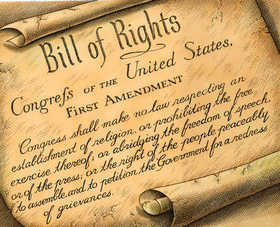| James Madison, one of the Framers of the Constitution, wrote a list of individual rights and limits on the government. After lengthy debates, most of these rights appear in the first 10 amendments, called the Bill of Rights. The Bill of Rights was ratified on December 15, 1791. Today, the US recognizes December 15 as Bill of Rights Day. |

The US Bill of Rights history and goals
The first 10 amendments to the United States Constitution are known as the Bill of Rights. When the Framers wrote the Constitution, they did not focus on individual rights. They focused on creating the system and structure of government. Many Americans believed that the Constitution should guarantee the rights of the people, and they wanted a list of all the things a government could not do. They were afraid that a strong government would take away the rights people won in the Revolutionary War.
James Madison, one of the Framers of the Constitution, wrote a list of individual rights and limits on the government. Most of these rights appear in the first 10 amendments, called the Bill of Rights. Some of these rights include freedom of expression, the right to bear arms, freedom from search without a warrant, freedom not to be tried twice for the same crime, the right to not testify against yourself, the right to a trial by a jury of your peers, the right to an attorney, and protection against excessive fines and unusual punishments. The Bill of Rights was ratified on December 15, 1791. Today, the US recognizes December 15 as Bill of Rights Day.
The authority to amend the Constitution of the United States is derived from Article V of the Constitution. An amendment may be proposed either by Congress with a two-thirds majority vote in both the House of Representatives and the Senate, or by a constitutional convention called for by two-thirds of the State legislatures. A proposed amendment becomes part of the Constitution as soon as it is ratified by three-fourths of the states (currently 38 of 50). None of the 27 amendments to the Constitution have been proposed by constitutional convention.
The Bill of Rights protects the rights of all US citizens and residents. Throughout the US Constitution, these fundamental rights are enshrined in law and can never be taken away without due process of the law. This ensures that no individual or group is ever deprived of their basic freedoms and liberties.
The Bill of Rights also serves as a powerful check on the power of the government by limiting its ability to pass laws that contravene the basic protections it provides for individuals. By ensuring that the government always respects individual rights and civil liberties, the Bill of Rights helps protect the individual and the population at large from tyranny and oppression.
The Bill of Rights is also an important part of the US national identity. It is a constant reminder of its founding ideals - that all people have certain inalienable, God-given rights that should not be infringed upon by any man or government. This is the cornerstone of American democracy and reinforces the commitment to freedom and justice for all.
The Bill of Rights began to take shape in mid-1789, roughly at the same time as the drafting committee's report, which recommended including a preamble listing the fundamental rights that the French Constitution should respect, as presented by Jean Joseph Mounier to the National Constituent Assembly, on July 9, 1789. The Declaration was promulgated by royal patent on November 3, 1789. Meanwhile, the Bill of Rights was formulated during a much longer period of debate that lasted until the end of 1791.
[ Más en español ]
Comments powered by CComment